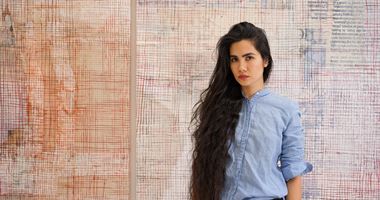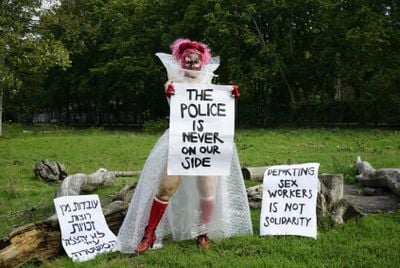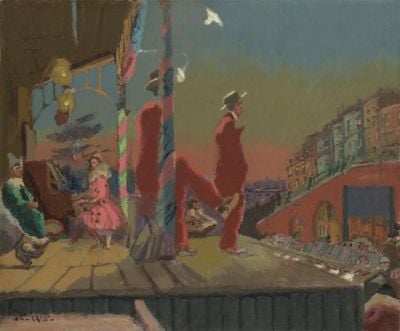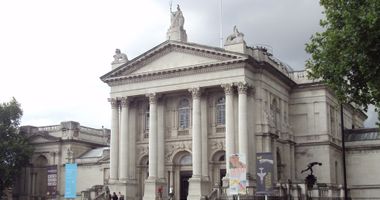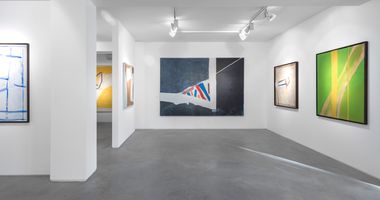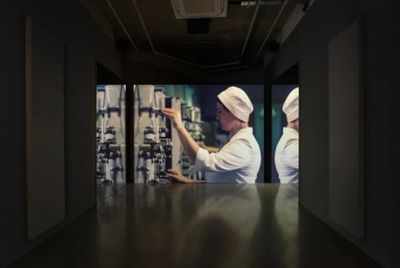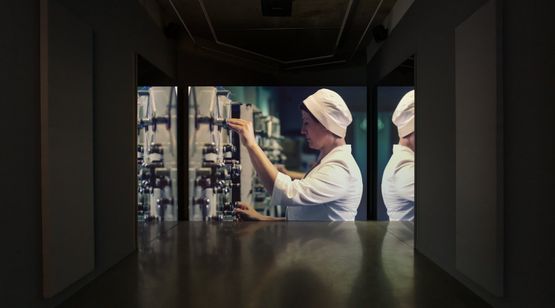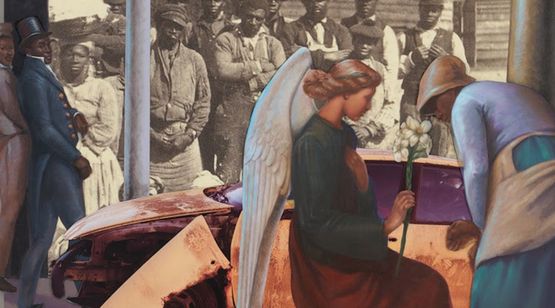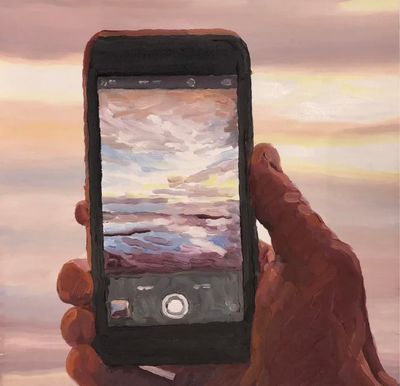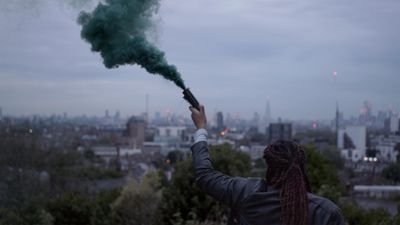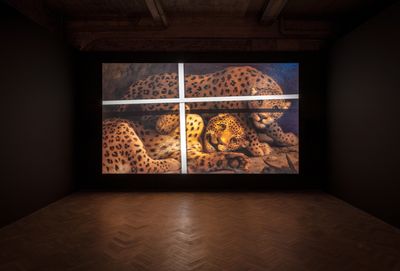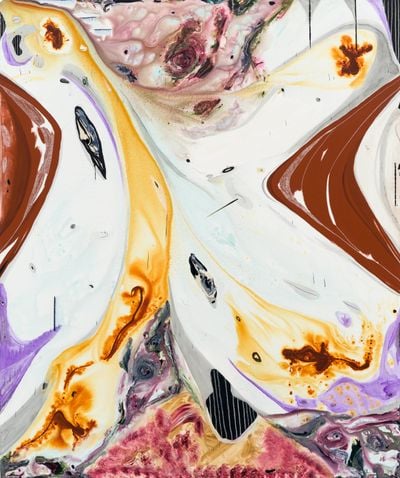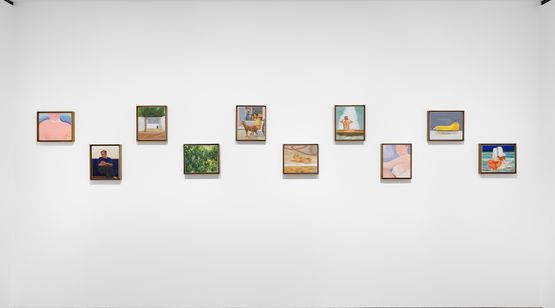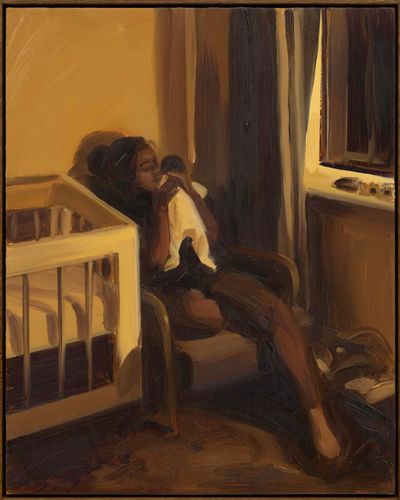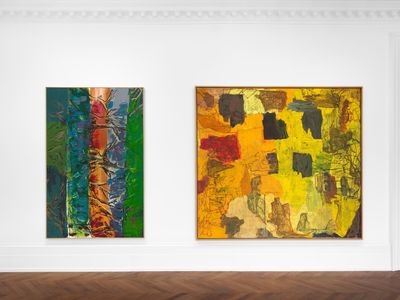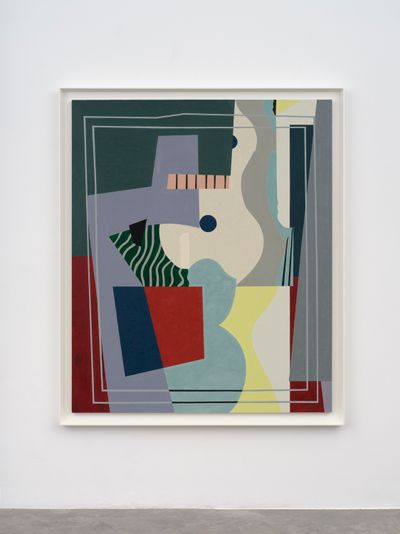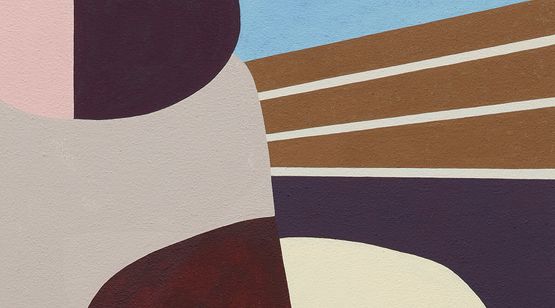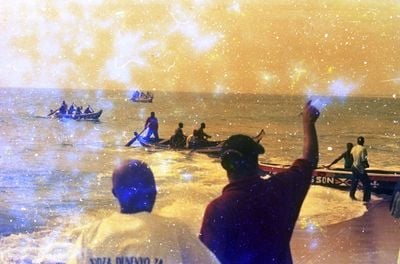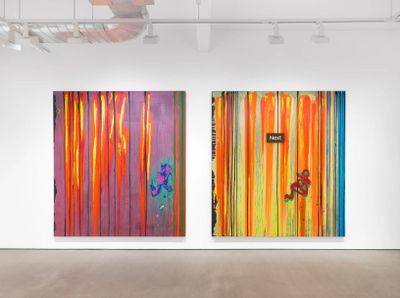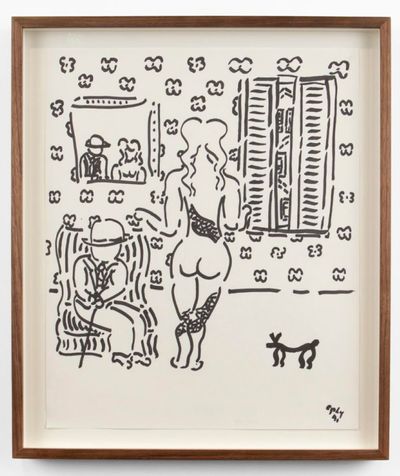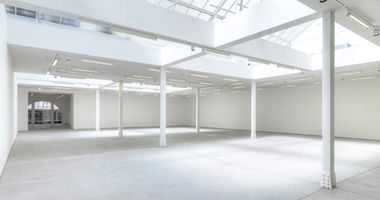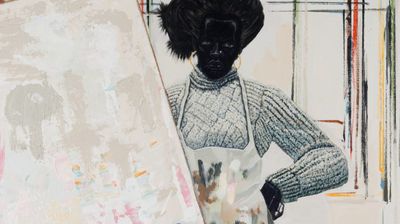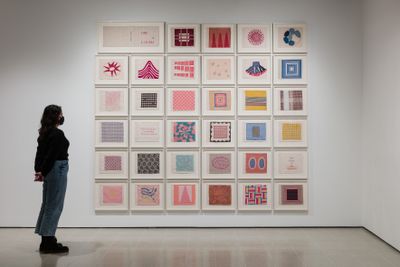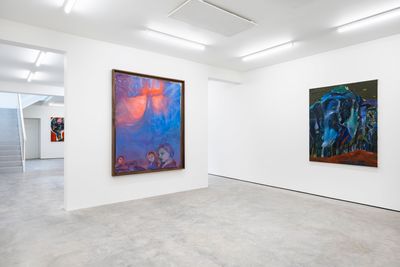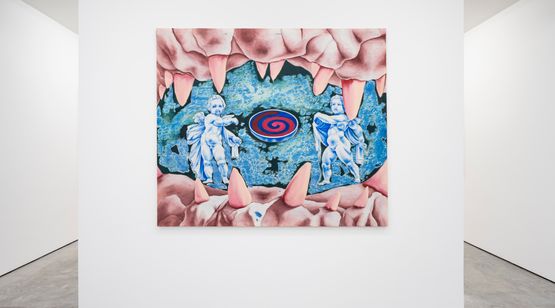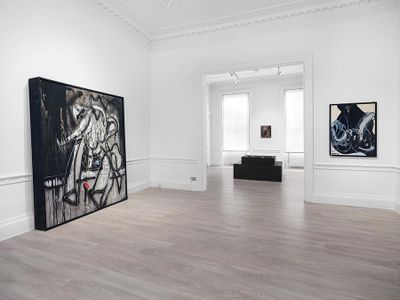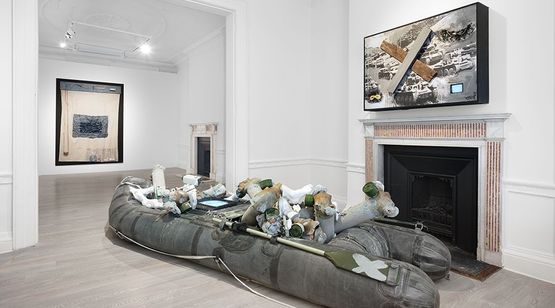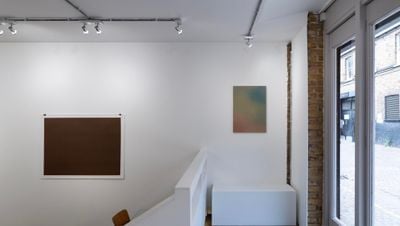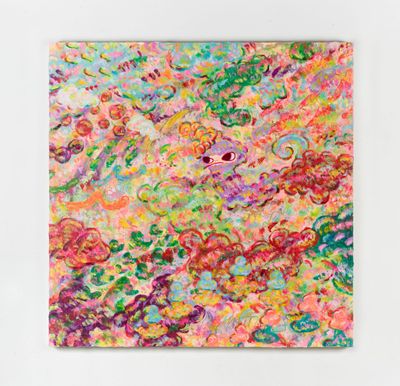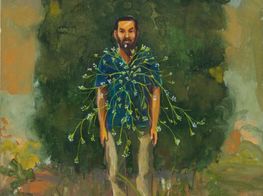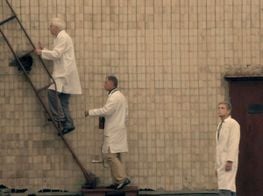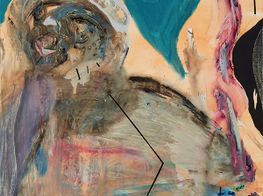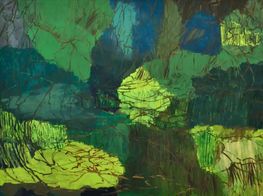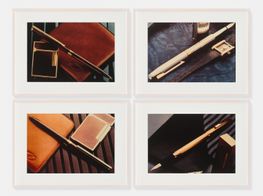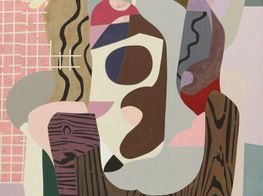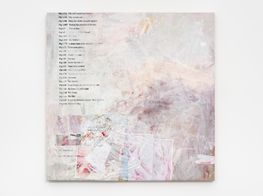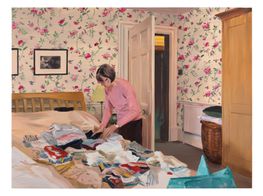London Gallery Weekend 2022: Exhibitions to See

Mandy El-Sayegh, Performance rehearsal (still), UTA Artist Space, Los Angeles (2022). Courtesy the artist and UTA Artist Space. Photo: Josh S. Rose.
With over 150 galleries showing during London Gallery Weekend (13–15 May 2022), the second edition of the public event has something for everyone. Find out what's happening in the city with our selection of must-see shows.
Mandy El-Sayegh: The Minimum
Various Locations, London Gallery Weekend
13–15 May 2022
Designed in collaboration with freelance choreographer Alethia Antonia, three performances over three days by Mandy El-Sayegh will explore how vulnerable bodies can express themselves.
Painted on the ground in three locations across London, an installation the size of a solitary confinement cell serves as a metaphorical stage to address the effect of regulated spaces on illicit bodies, kept away from society for security purposes. While such spaces may appear to benefit the collective, they are equally grounds that suppress the senses and revoke the autonomy of individual subjects, the artist suggests.
Decriminalised Futures
Institute of Contemporary Arts London, The Mall, St. James's
16 February–22 May 2022
Speaking to the multiplicity of experiences that frame contemporary sex work, Decriminalised Futures looks at the liberation movement of sex work and its relationship to human rights and social and racial justice across the works of 13 artists.
Calling for a full decriminalisation of sex work, the exhibition is conceived as a 'celebration' of the movement's progression, told through feminist, trans, queer, migrant, and disabled perspectives, including moving image, embroidery, bookmaking, sculpture, and gaming.
In the upper galleries, Stove Dove (2021) by Chi Chi Castillo and May May Peltier explores the lives of four sex workers of colour, while Liad Hussein Kantorowicz's Mythical Creatures (2020) tells the story of the very first sex worker organisation in Palestine-Israel, Argaman Alliance.
Walter Sickert
Tate Britain, Millbank
28 April–18 September 2022
A major figure among 20th-century painters working in Britain, German-born painter and printmaker Walter Sickert's influence on the British avantgarde is surveyed for the first time in 60 years, with emphasis on the artist's radical approach to setting and subject matter.
From Paris to Venice, the artist, known to be a cosmopolitan and an eccentric, rendered ordinary people in urban settings, with loose strokes and ample inspiration, and subdued interiors taking after French Impressionism as well as his mentor and friend Edgar Degas.
Created after a stay in Brighton, the oil on canvas painting Brighton Pierrots (1915) offers viewers a detached view of a staged performance in which performers and their bright costumes are intercepted by a pavilion structure, overlooking a crowd at dusk.
Henri Affandi: Roots
Huxley-Parlour, 3-5 Swallow Street
30 April–16 June 2022
Starting from the concept of roots to explore the role of cultural diversity in the upkeeping of the British Empire and contemporary Britain, London-based Indonesian artist Henri Affandi transforms the lower gallery space at Huxley-Parlour into a hanging-textile root cave.
With colourful suspended fabrics from different global cultures presented besides an audio work of migrants relating their heritage and experiences, Affandi's mix-media installation reflects the multiplicities within Britain, acting as an 'anthology' of stories, founded in a place that can be at once hostile and home.
Jane and Louise Wilson: The Toxic Camera
Maureen Paley, 60 Three Colts Lane and Studio M, 7 Playground Gardens
29 April–5 June 2022
Made by collaborators Jane and Louise Wilson, whose work has explored sites of historical and political tension throughout time, the 2012 video installation The Toxic Camera departs from Ukrainian filmmaker Vladimir Shevchenko's film Chernobyl: A Chronicle of Difficult Weeks (1987), which recorded the aftermath of the disaster.
The Toxic Camera was filmed outside of Kyiv, where Shevchenko's Konvas Avtomat camera was buried two years after he documented Chernobyl—not before the artist himself passed away from radiation exposure.
Shevchenko's film was refused by the Russian press who claimed it contained 'radioactive particles' on screen, eventually shown at the Tbilisi Film Festival in Georgia for the first time.
Alongside the video, collaged images of archives showing Chernobyl's former residents and a bronze-cast replica of Shevchenko's 16-millimetre film camera will be shown across the two spaces, tying past occurrences to the present through the idea of 'future ruin'.

Titus Kaphar: New Alters: Reworking Devotion
Gagosian, 20 Grosvenor Hill
17 March–15 May 2022
Amid increasing calls for racial representation, Titus Kaphar's portraits recalling 18th-century European painting remind viewers that marginalised subjects remain at the periphery of the art historical canon.
In Kaphar's work, Black faces are cut away, crumpled, concealed, or quite literally hidden behind a curtain printed with the face of some George Washington look-alike.
These techniques are recovered for the artist's first exhibition in London, which critically examines the use of historical images to inform an alternative present by highlighting the artifice of representation through off-sized, shaped canvases and layered sculptures.
In the oil on canvas An Illusion of Progress (2022), a young Black girl holds a corpse-like infant above a mountain of black-and-white faces of American presidents. A golden cloth is draped over one corner of the red enamel frame, alluding to a dramatic unveiling.
Cynthia Daignault: Xanadu
The Sunday Painter, 117-119 South Lambeth Road
4 May–4 June 2022
Cynthia Daignault's engagement with painting and digital media is refreshingly uncynical, at once drawing out the medium's capacity for timeless cinematic rendition, while acknowledging the ways of looking introduced by technological change.
For Xanadu, Daignault will be showing flat, oil-on-paper works for the first time, referencing their digital images. The gallery itself becomes a stand-in for platforms like Google and Instagram, with each wall representing one work.
Hinting at the possible co-existence between mindful presence and digital documentation, a phone screen held by a hand displays a rose-toned sky in the oil on paper Punk is Dead (2022), rendered just as appealing, if not more so, than the backdrop it attempts to capture.
Screening: H is for Hostile Environment
Rio Cinema, 107 Kingsland High Street
11 May 2022
Presented by Chisenhale Gallery, the collaborative film by Edwin Mingard and researcher Dr Keren Weitzberg paints a vivid portrait of the faces that populate East London, gathering the tales of people who have experienced the U.K.'s anti-immigration policies.
From Pouyan who fled the Iranian regime to Usman's 50-day sojourn in a detention centre, we learn what it's like to live under the radar, told by an undocumented Londoner who explains his reasons for moving.
Reflecting fluid population flows facing rigid border regimes, an initial screening of the video work will take place at Rio Cinema shortly before the opening of London Gallery Weekend.
Amie Siegel: Bloodlines
Thomas Dane Gallery, 3 and 11 Duke Street
27 April–23 July 2022
Produced in private estates throughout England and Scotland, the large-scale moving-image work Bloodlines (2022) traces the life of English painter George Stubbs, from aristocratic parlours and private country houses to the public art gallery.
Inquiring into the mechanisms of inherited wealth, cultural property, and the relationship between an artwork and its audiences, Bloodlines addresses ever-pertinent binaries across rich visuals that look into the very dynamics of image-making.
Manuel Mathieu: Keeping things whole
Pilar Corrias, 54 Eastcastle Street
28 April–28 May 2022
Known for abstracted figurations of haunting, amorphous forms that evoke Bacon's disfigured protagonists, Haitian-born Montreal-based painter Manuel Mathieu, who recently joined Pilar Corrias, contends with Haitian political history and its relationship to his family in this recent body of work.
Presented as a process of (self) discovery, paintings that compose Keeping things whole form an internal landscape of sorts, reflecting the ravage of political strife and displacement on the body.
In the mix-media painting Keeping Things Whole (2021), two individual cells containing abstracted figures rendered in travelling strokes appear to originate from the same organism, perhaps alluding to the internal divisions created by shifting identities over time.
Mahesh Baliga: Drawn to remember
David Zwirner, 24 Grafton Street
12 April–28 May 2022
Mahesh Baliga's quiet paintings of life in Vadodara, west-central India, are like tiny memorabilia to be carried in one's pocket to counter the fallibility of memory. Painted in casein tempera, a row of these 'lap-sized' works are on show at David Zwirner, alongside some larger paintings.
Regardless of his subject matter, Baliga's protagonists are depicted wrapped in an aura of serenity—an act of care by the artist by choosing not to represent people as they are, but as he hopes they can be. Such is the case for Eye Hospital (2022), which offers a particularly bright outlook of an otherwise lifeless place.
Richard Prince: Shop Takeover
Gagosian Shop, 28-29 Burlington Arcade
10–28 May 2022
With Richard Prince: Hoods opening at Gagosian, New York, the chronicler of American subcultures will be taking over the recently opened Gagosian shop in Burlington Arcade, transforming the space into a hippie den, with a recent painting (2021), yet-to-be shown 'High Times' drawings (2016–2018), and a miscellany of posters and books expanding on the exhibition in New York.
There, paintings made from car hoods from the 1960s and 70s, hand-sanded and painted by the artist, present nostalgic references to D.I.Y. car culture and the post-war avantgarde penchant for the abstract and the ready-made.
An early preview of Prince's book documenting the making of the hood paintings will also be available on-site, alongside collectibles, apparel, and furniture from the Katz + Dogg line made in collaboration with L.A.-based designer Darren Romanelli.
Caroline Walker: Lisa
Stephen Friedman Gallery, 25-28 Old Burlington Street
29 April–28 May 2022
Known for large-scale representations of women performing domestic labour, Scottish painter Caroline Walker documents her sister in law's journey as a mother this time, shadowing the latter with a camera for four months to capture her day-to-day.
At once personal and objective, Walker's documentations reflect the artist's attitude towards her subjects, tossing a rose-coloured veil over the experience of motherhood in this case, which imbues moments of repose and intrigue into the seemingly thankless and mundane.
An air of calm follows Lisa, who is rendered with lively palettes folding baby clothes, washing dishes, or feeding baby Layla without a hint of tiredness. Even as the sun sets, in the triptych Night Feed (2022), the mother-daughter pair bask in the golden hues of dusk, stretched out besides the crib, content.
Per Kirkeby: Geological Messages: Paintings from 1965-2015
Michael Werner Gallery, 22 Upper Brook Street
24 February–21 May 2022
You don't need to know of Danish painter Per Kirkeby's work to notice the artist's interest in natural ecologies, plant-life, and architecture. Nor do you need to look for long before being hit by their liveliness.
The former Fluxus member, who partook in Joseph Beuys' 'Happenings' in the 1950s and 60s, always seemed to be very physically involved with his subject matter, first studying geology before acquiring first-hand experience working in Greenland and the Antarctic.
Accordingly, Kirkeby's abstracted landscapes appear almost human, drawing out the textures and substructures of nature and the layers of the earth, which vibrate across thick applications of soil-toned strokes, alternating with bright yellows and oranges introducing motion.
Rodney Graham: Painting Rocks
Lisson Gallery, 67 Lisson Street
26 April–25 June 2022
A self-proclaimed Duchamp follower, Rodney Graham, mostly known for conceptual works, video, and installation, seems to approach painting with sincerity this time, with a body of new works that follow from 'Painting Problems' (2020)—paintings made from former paintings.
Taking analytic Cubism as its starting point, Graham's fragmented assemblages of layered geometric forms incorporate motifs like buttons and zebra stripes to form harmonious surfaces with a subtle appeal.
Made from cutting images of paintings, rotated and transformed using Photoshop, works in Painting Rocks show a curious entanglement of influences that borrow from the art historical cannon without positioning itself within or against its traditions.
Adjoa Armah: The sea, it slopes like a mountain
Auto Italia, 44 Bonner Road
28 April–24 July 2022
Following a 330-mile journey along the Ghanaian coast, Ghanaian artist, writer, and design anthropologist Adjoa Armah produced a series of sketches of European and North-American museum objects with sand gathered from different locations along the way.
The latter are staged on a platform that recreates areas of an ashanti abosomfie (shrine house) with its traditional orange-red hues, where images of ceremonial objects and musical instruments on mercury-backed mirrors explore the transformative properties of material change.
Closing the gaps between time, recorded sounds from the artist's travels—birdsong, conversations, and recordings of the sea—perform a momentary recovery of bygone ways of transmission.
John Hoyland: Flames Like Rainbows
Hales, 7 Bethnal Green Road
1 April–20 May 2022
Among the earliest abstract painters in the U.K., John Hoyland and his colour-fields have come a long way; from early geometric compositions to dynamic strokes taking on the residual energy of motion—as flamboyant and unpredictable as the exhibition title suggests.
Marking a pivot in the artist's practice, works on view follow Hoyland's stay in Bali in 1994. Struck by its landscapes, Hoyland started introducing direct references of natural forms, trees, flags, water, to previously calligraphic shapes.
Reflecting the aftermaths of vivid encounters, Jump 21.5.01 and Fall 28.3.2001 (both 2001), draw inspiration from students diving from Jamaica's Negril cliffs. Translated as dripping yellows and fiery reds, Hoyland transmits the experience of heat, replicating the motion of freefall on a warm summer day.
William N. Copley
Sadie Coles HQ, 1 Davies Street
5 May–18 June 2022
American painter, curator, and collector William N. Copley, also known as CPLY, was notable for his provocative, figurative style that illustrated personal fantasies of adultery, death, and desire.
For the present exhibition, influences from the last decades of Copley's life emerge across drawings, shown in the U.K. for the first time, and a single painting that embodies the bulbous figures, lines, and surfaces that would come to define Copley's practice.
In the monochrome painting Philosophie dans le boudoir (1965), a woman rendered in broken curved lines stands in a brassiere in a densely patterned room. The space is flattened into a single surface, as if to emphasise its nature as an image, as the product of imagination.
A Century of the Artist's Studio: 1920–2020
Whitechapel Gallery, 77-82 Whitechapel High Street
24 February–5 June 2022
Surveying not the practice of any artist but the studio environment itself, A Century of the Artist's Studio gathers over 100 works by 80 artists around the world, exploring the potential of creative spaces, be it attics, abandoned factories, or kitchen tables.
From the known—Duchamp, Bacon, Picasso, Warhol, to the contemporary, Kerry James Marshall, or Lisa Brice, the studio as artwork is presented besides photo-documentations of studio spaces across time, while 'corner studio' installations replicate the production grounds of iconic works.
Louise Bourgeois: The Woven Child
The Hayward Gallery, Southbank Centre, Belvedere Road
9 February–15 May 2022
With a rare focus on textile and fabric works from Louise Bourgeois' later years, The Woven Child shows a lesser-seen, yet unsurprising facet of the artist's sculpture-dominant practice, with her massive steel spider Maman (1999) perhaps preceding a shift to softer, more domestic mediums.
Positing a psychological resolution of sorts, woven garments, doomsday clocks, and serial patterns spread across galleries unfold time to contend with the significance of birth, death, and what to be done with the dreary space in-between. The 35-panel installation of fabric collages and lithoprints, Ode à l'oubli (2004) seems to hold the answer: take it all out, and abstract it if you must—and forget.
Of Foxes and Ghosts
MAMOTH, 3 Endsleigh Street
7 May–11 June 2022
Inspired from Pu Songling's Strange Tales from a Chinese Studio (1740), a Chinese classic containing over 500 tales commenting on 18th-century society, Of Foxes and Ghosts inquires into the ghost bodies that intrude on human lives, be it the ecological crisis or power imbalances.
Offering visual metaphors responding to pervasive geopolitical forces, seven artists, including Maya Bloch, Antonia Kuo, and Henry Curchod, contend with the power of allegory to deliver social critique.
Beyond abstract contemplation, a more immediate response will take place simultaneously, with the exhibition raising funds to be donated to Ocalenie Foundation, a non-profit supporting Ukrainian refugees, in the context of the current war in Ukraine.
Wolf Vostell: Destruction is Life
Cardi Gallery, 22 Grafton Street
25 April–23 July 2022
Among the founders of the Fluxus movement, German painter, sculptor, and installation artist Wolf Vostell was a strong believer in the prevalence of destruction, and was accordingly known for blurring and overpainting images.
These processes extended to objects, among which television sets embedded into artworks, from 1958, which were among the first installations made at the time—pioneered by Vostell, alongside video mediums.
Spread across three floors, this first retrospective at Cardi Gallery traces the artist's engagement with art and life, and what follows from the boundary's erasure, including videos, paintings, sculptures, and installations from 1967 to 1998.
William Brickel: Far From Anything
The Artist Room, 76 Brewer Street, F3
5–28 May 2022
To say that William Brickel's contorted portraitures are psychologically charged would be an understatement. In Brickel's work, the human figure articulates the subject's internal states, given oversized arms or side-cast gazes that betray their placid expressions.
New paintings, large-scale charcoal drawings, and watercolours are included in the artist's first exhibition with The Artist Room, most of which begin from Brickel's own physical sensations.
Speaking to the impossibility of knowing another's internal states, a smaller series of five oil paintings on board depict withdrawn figures looking out, appropriately titled 'Strangers' (2022).
Bad Manners
Luxembourg + Co., 2 Savile Row
1 March–15 May 2022
Organised in collaboration with Jake Chapman of the Chapman Brothers, who have, among other things, painted rainbows over Hitler's watercolours, Bad Manners reflects on originality and authorship within artistic production from the 19th century to the present.
Featuring 'non-consensual collaborations', works on view include a table sculpture made using a Gerhard Richter 'Grey' painting (1970s), a Double Portrait of Richard Prince and Cindy Sherman, and Chapman's own watercolour rendered atop a Manet etching.
As Chapman suggests, the history of bad manners and the history of modern art are the same. A text publication with anecdotes documenting such a history of appropriation and physical modifications will be available alongside the exhibition.
Stephan Baumkötter: Recent works
Bartha Contemporary, 7 Ledbury Mews North
3–19 May 2022
From afar, Stephan Baumkötter's earth-toned colour fields appear as monochromatic blocks with hints of adjacent shades that suggest something else might be happening.
A play on perception, they urge viewers to keep looking and return to their surfaces, which change under different conditions of light—an element of chance the artist considers to be inherent to the process and becomes representative of emotional states.
Looking back on his career spanning four decades, works on show begin from the artist's recollection of his time with Donald Judd in Marfa, resulting in the body of new paintings on paper and four small canvases.
Ayako Rokkaku: Imagination for Flying Adventure
KÖNIG, 259 Old Marylebone Road
13 May–11 June 2022
Ayako Rokkaku's rippling rainbow fields painted by hand take inspiration from manga drawing and kawaii culture, featuring cartoon characters including wide-eyed cats and pensive young girls dwelling in the fictional plane of the artist's vivid, childlike imagination.
Each painting appears to contain its own narrative, while fitting into the greater landscape of the artist's practice, who, beyond the canvas, has taken to painting on other surfaces like cardboard and suitcases.
In these open-ended spaces, the rigid proportions of traditional painting are set aside to make space for 'adventure', with the present exhibition offering insight into the artist's energetic engagement with these acts of transportation. —[O]


